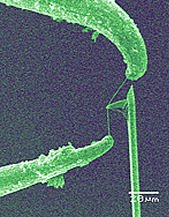A thin wire cuts through cheese more easily and cleanly than a flat blade does. Now, researchers have built a microscopic version of a cheese slicer—with a carbon nanotube for a wire—that’s aimed at making improved slices of frozen cells.

Biologists have long used diamond blades, known as microtomes, to section flash-frozen cells into thin slices in preparation for microscopic scrutiny. However, such a wedgelike blade bends the top of the slice as it cuts, often creating cracks in the sample, says mechanical engineer Paul S. Rice of the Boulder campuses of the National Institute of Standards and Technology and the University of Colorado.
Using an electron microscope, he and his colleagues steered a micromechanical probe capable of 5-nanometer motions to pluck a single nanotube from a mass of twisted strands. Then, the researchers fired the beam of the electron microscope to spot weld the tube between the tips of two tungsten needles.
So far, welds have failed when the team has tested the nanotube setup’s strength with the tip of an atomic-force microscope, reported team member Gurpreet Singh of the University of Colorado in November at a mechanical engineering conference in Chicago. However, better welds are on the way, says Rice, and the team has begun initial cutting experiments on softer-than-ice materials.





